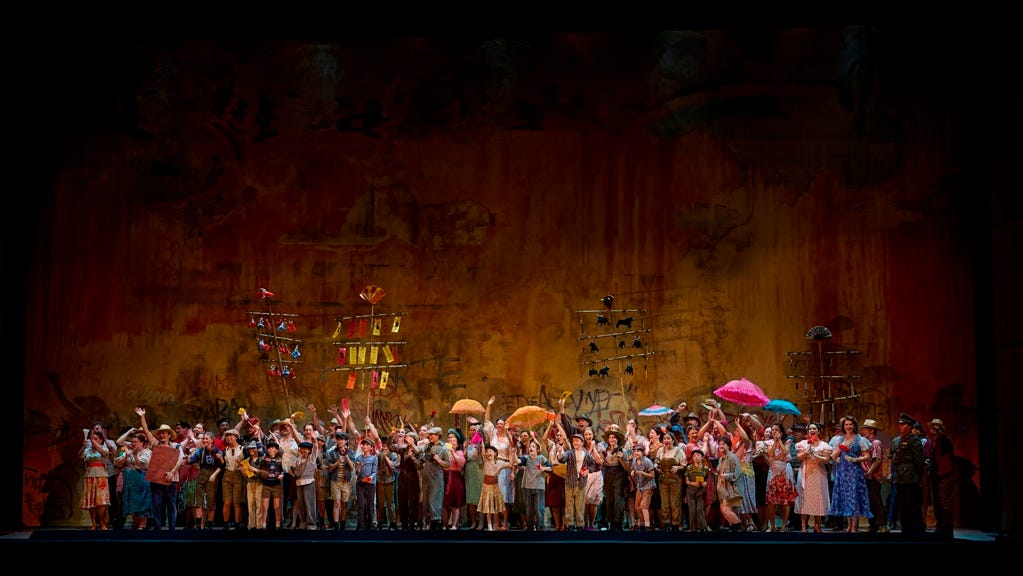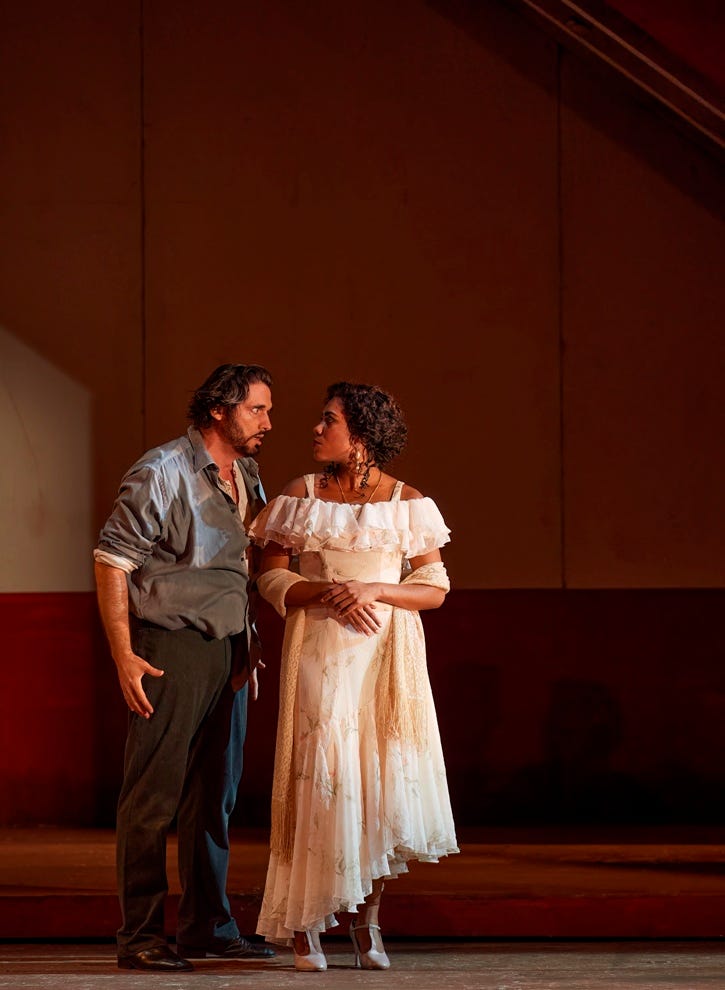The olden but perfectly serviceable production of Carmen, last seen in 2016, reopened at the COC last night in a Joel Ivany revival. The star of the show was the COC orchestra under Jacques Lacombe which went full-on immediately in the overture and stayed energetic and at a fast clip till the end. The woodwinds were particularly mellifluous when taking the floor: what CGI magic was that, guys? There was not a bar of humdrum playing in any section, though. Even if one would perhaps prefer one’s quintet at the Lillas Pastia’s a little slower, this pace convinced me too. It was a great night in the pit.
On stage, the matters were more in the OK range. The sets do the job, and the one in the last scene in particular, backstage at the corrida, is laid out well, the bull-fighting audience visible in their seats while the private murderous drama unfolds underneath the arena. The first set of the opera is the iron gate of the soldiers’ quarters which does not change for the cigarette factory – the female workers come out and Carmen sings her most famous aria about the fickleness of love in front of the gates. Act one is crowded with choruses, extras and principals all jostling before the gates, the space behind the gates remaining underused. (The gates could have been placed sideways for example, instead of end to end.) The act chez Lillas Pastia shows a modest tavern on a modest square criss-crossed by some rudimentary lighting. The scene in the mountains, set in and around a derelict building, possibly a former church, breathes more easily and uses the space better. The concluding scene is, finally, masterful. The procession with the picadors, l’Espada, the toreador etc. before they enter the arena takes place in the FSC audience, where Don Jose also lurks in corners before coming out to face Carmen.
Does anyone need a Carmen synopsis at this point in the history of its planetary domination? Probably not; back when I was opera blogging, I also reviewed the ENO Opera Guide on Carmen, and those people know how to put together an opera guide. Highly recommend it. (Did you know for ex that Bizet died three months after the catastrophic premiere, believing he produced a dud? The injustice of it all.) There have been some recent productions that teased out the bits of the opera that might be particularly interesting to today’s audiences. As everything takes place in a sort of military occupation, where soldiers are in charge of enforcing the laws, some directors have pushed the era to the twentieth century and Franco’s Spain. Others, like David McVicar, have created detailed psychological profiles of the principals; Don Jose is a fugitive from justice obsessed with his mother, for example. Still others, like Kosky, deconstructed the whole thing: Kosky shoehorned into his own production the history of reception of Carmen and her cultural meaning(s). I am partial to the McVicar-Von Otter Carmen from Glyndebourne, and it’s the measuring stick with which I rate all the others, but there have been other great Carmens. And a lot of awkward ones, it must be said. We all have “our” standard Carmen.
The smoothest singer in this COC cast for me was Marcelo Puente as Don Jose. His acting was right, his voice even better: clear, bold, and even throughout the register. Not surprisingly, his “Le fleur que tu m'avais jetée” was the first big applause of the night. The two female principals, I’m grumpy to report, are not entirely my cup of Seville orange mimosa. J’Nai Bridges is a glamourous, talented singer whose voice blooms wonderfully in the lower register but whose overall performance struck me as… OK. Sparks did not fly, but everything was also perfectly fine. (My opera companion, whose first Carmen this was, was more favourably disposed, and it’s possible that multiple viewings have spoiled/jaded one.) Micaela too didn’t really charm vocally, and Joyce el-Khoury too is a glam performer with a successful career. Sometimes some voices just leave us cold, and others slightly irritated, though nothing technically might be wrong with them. It’s one of the opera’s mysteries. Some singers produce the text-physique-music alchemy for some people, and others don’t.
Lucas Meachem as Don Escamillo was also perfectly fine, and I appreciated the slight ironic distance from the character – the hysteria around him is ever so slightly exaggerated in this production, and he happens to be less foxy than Don Escamillos usually are. I like the idea of a regular-looking Don Escamillo. He charms Carmen with the force of his personality, and his reputation.
I’ve read somewhere that this production is a sure best seller for the COC whenever it’s revived, and that’s great to hear. A lot of it is to do with the work itself, which, if played and sung competently, is always worth coming out for and bringing opera newbies to. It’s a brilliantly constructed opera which premiered when it was ahead of its time and which is still not past it, nor will it be any time soon. And boy does it still get people talking. The anti-femicide ending in a 2018 production in Italy was just one of the many outbursts of Carmen-related controversy in its 140-year history. May it have many more into the next century.
Returns Oct 16, 20, 22, 26, 28, 30 and Nov 4 at the Four Seasons Centre for the Performing Arts. Approximately 3 hrs with one intermission.
PS: Should I write about Opera Atelier’s Dido and Aeneas? I’m not a fan of the company’s choreographed performance style, but Purcell is one of my favourite people. What to do?





Great review! I saw Puente a few years ago at COC in Tosca (with Pieczonka) and liked him a lot.